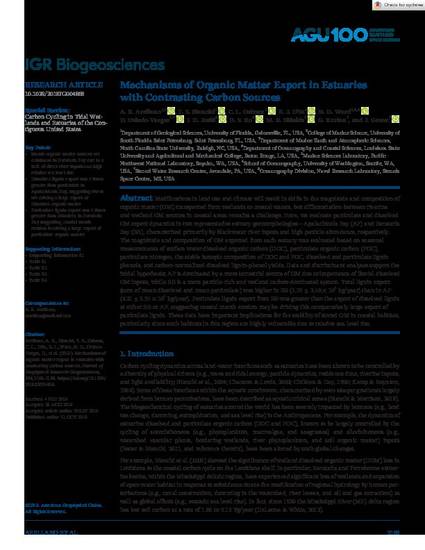
- OC export,
- lignin export,
- carbon cycling in estuaries,
- stable carbon isotopes,
- wetland carbon,
- OC sources
Modifications in land use and climate will result in shifts in the magnitude and composition of organic matter (OM) transported from wetlands to coastal waters, but differentiation between riverine and wetland OM sources in coastal areas remains a challenge. Here, we evaluate particulate and dissolved OM export dynamics in two representative estuary geomorphologies—Apalachicola Bay (AP) and Barataria Bay (BB), characterized primarily by blackwater river inputs and high particle abundance, respectively. The magnitude and composition of OM exported from each estuary was evaluated based on seasonal measurements of surface water dissolved organic carbon (DOC), particulate organic carbon (POC), particulate nitrogen, the stable isotopic composition of DOC and POC, dissolved and particulate lignin phenols, and carbon-normalized dissolved lignin-phenol yields. Data and discriminant analyses support the initial hypothesis; AP is dominated by a more terrestrial source of OM due to importance of fluvial dissolved OM inputs, while BB is a more particle-rich and wetland carbon-dominated system. Total lignin export (sum of mean dissolved and mean particulate) was higher in BB (5.73 ± 2.50 × 105 kg/year) than in AP (4.21 ± 2.35 × 105 kg/year). Particulate lignin export from BB was greater than the export of dissolved lignin at either BB or AP, suggesting coastal marsh erosion may be driving this comparatively large export of particulate lignin. These data have important implications for the stability of stored OM in coastal habitats, particularly since such habitats in this region are highly vulnerable due to relative sea level rise.
Journal of Geophysical Research: Biogeosciences, v. 124, issue 10, p. 3168-3188
©2019. American Geophysical Union. All Rights Reserved.
Available at: http://works.bepress.com/anaarellano/5/
